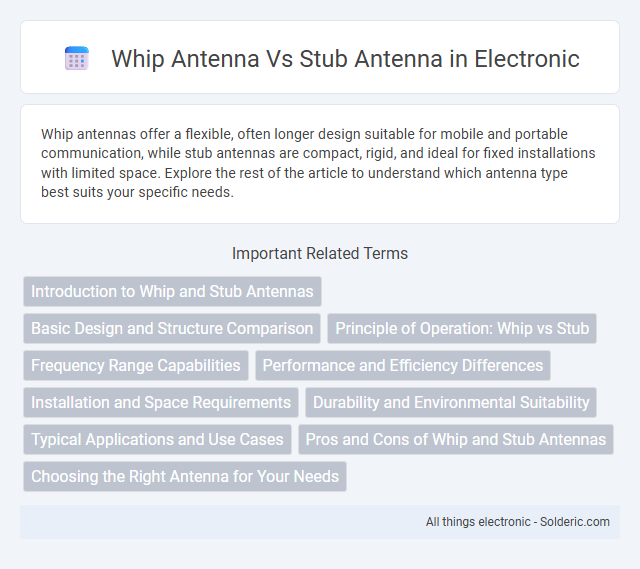Whip antennas offer a flexible, often longer design suitable for mobile and portable communication, while stub antennas are compact, rigid, and ideal for fixed installations with limited space. Explore the rest of the article to understand which antenna type best suits your specific needs.
Comparison Table
| Feature | Whip Antenna | Stub Antenna |
|---|---|---|
| Structure | Flexible rod, typically quarter-wavelength | Shorted transmission line segment |
| Size | Longer, usually quarter wavelength | Shorter, electrically lengthened via stub |
| Frequency Range | Broadband, suited for VHF/UHF | Narrowband, designed for specific frequencies |
| Radiation Pattern | Omnidirectional in horizontal plane | Directional or modified pattern based on stub design |
| Impedance Matching | Generally 50 O, easy matching | Requires precise design for impedance match |
| Applications | Radio, mobile communications, handheld devices | Filters, antenna tuning, compact antenna designs |
| Durability | Flexible, prone to bending | Rigid, more robust |
| Cost | Low cost | Moderate to high due to design complexity |
Introduction to Whip and Stub Antennas
Whip antennas are slender, flexible rods typically used for VHF and UHF frequency bands, offering omnidirectional radiation patterns and portability. Stub antennas, often shorter and using a reactive element or transmission line segment, provide compact designs suitable for limited-space applications while maintaining efficient impedance matching. Both antennas serve different needs in communication systems, with whip antennas favored for extended range and stub antennas preferred for discreet installations.
Basic Design and Structure Comparison
A whip antenna consists of a straight, flexible rod that typically operates as a quarter-wave monopole, providing omnidirectional radiation suitable for handheld or mobile devices. In contrast, a stub antenna employs a shorted transmission line section or a resonant length of conductor, often mounted perpendicular to the main transmission line, which allows for compact size and specific frequency tuning. Your choice between these two depends on factors like desired frequency range, physical space constraints, and radiation pattern requirements.
Principle of Operation: Whip vs Stub
Whip antennas operate on the principle of resonance, using a quarter-wavelength conductive rod to efficiently radiate or receive electromagnetic waves by creating standing waves along its length. Stub antennas utilize a short-circuited or open-circuited transmission line segment to create impedance matching and radiation through reactive elements, relying on the reflection of signals within the stub to establish resonance. The whip antenna's operation is inherently broadband and physically oriented, whereas the stub antenna's function depends on its electrical length and placement within the feed network for effective signal transmission.
Frequency Range Capabilities
Whip antennas typically operate efficiently over a broad frequency range, from VHF to UHF bands, making them versatile for mobile and portable communications. Stub antennas, often designed for specific frequencies, focus on narrowband performance with optimized resonance at designated points like HF or lower VHF bands. Your choice depends on the required frequency range coverage and application-specific needs.
Performance and Efficiency Differences
Whip antennas generally offer better performance and efficiency due to their longer length and ability to resonate at lower frequencies, making them ideal for broader frequency ranges and improved signal penetration. Stub antennas, being shorter and compact, provide limited bandwidth and reduced gain, often resulting in lower efficiency but greater convenience in size-restricted applications. Your choice should consider the trade-off between the whip antenna's superior signal strength and the stub antenna's compact design when optimizing for specific communication needs.
Installation and Space Requirements
Whip antennas require vertical mounting and more clearance space for optimal signal transmission, making them better suited for open areas or vehicle installations. Stub antennas have a compact design with shorter length and easier installation, ideal for limited space environments such as handheld devices or confined mounting locations. Your choice depends on available installation space and the need for unobtrusive antenna placement.
Durability and Environmental Suitability
Whip antennas, constructed with flexible metal rods often coated for corrosion resistance, offer superior durability in harsh weather conditions such as wind, rain, and snow, making them ideal for outdoor and mobile applications. Stub antennas, typically shorter and rigid with fewer moving parts, provide reliable performance in stable environments but may be more susceptible to physical damage under extreme environmental stress. Both antenna types require proper material selection and maintenance to enhance longevity, but whip antennas generally excel in withstanding environmental challenges due to their robust, flexible designs.
Typical Applications and Use Cases
Whip antennas are commonly used in mobile communication devices, such as handheld radios and vehicle-mounted transceivers, due to their omnidirectional radiation pattern and ease of installation. Stub antennas find typical applications in compact wireless devices like Bluetooth headsets and GPS receivers, where space constraints and discrete design are crucial. Your choice between these antennas depends on application requirements, including size limitations and radiation coverage.
Pros and Cons of Whip and Stub Antennas
Whip antennas offer superior range and omnidirectional reception, making them ideal for vehicles and portable radios but tend to be longer and more susceptible to physical damage. Stub antennas provide a compact and durable solution suitable for urban environments and modern devices, yet they generally sacrifice range and signal strength compared to whip antennas. Choosing the right antenna depends on your need for portability and durability versus maximum performance and range.
Choosing the Right Antenna for Your Needs
Whip antennas offer broad frequency coverage and flexibility, making them ideal for mobile and portable communication devices, while stub antennas provide a compact form factor suited for limited space and specific frequency bands. Your choice depends on the balance between size constraints, frequency requirements, and desired signal range in your application. Evaluating these factors ensures optimal performance and efficiency for your wireless communication system.
whip antenna vs stub antenna Infographic

 solderic.com
solderic.com